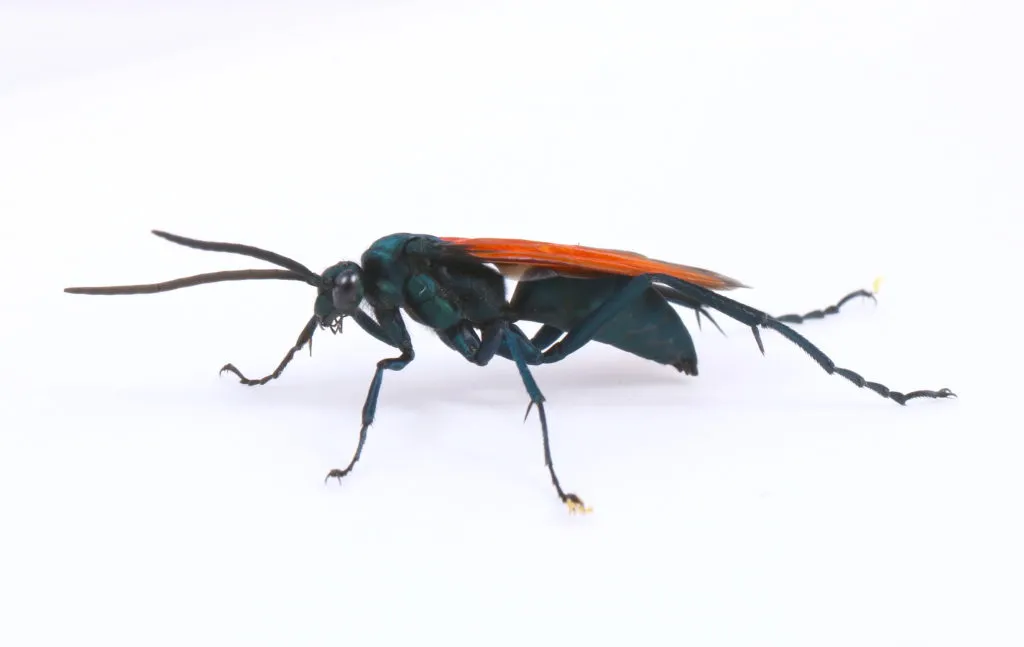What are Tarantula Hawks?
Tarantula hawks are a fascinating group of large, powerful wasps known for their striking appearance and their unique hunting behavior. These insects belong to the family Pompilidae and are renowned for their ability to paralyze tarantulas, which they then use as hosts for their larvae. They are a testament to the incredible diversity and complexity of the natural world, showcasing a specialized predator-prey relationship that has evolved over millions of years. Their presence often signals a healthy ecosystem, as they play a crucial role in regulating tarantula populations. These wasps are not only impressive predators, but also play a role in pollination as adults, adding another layer to their ecological significance. Understanding these wasps goes beyond mere curiosity; it provides insight into the delicate balance of nature and the interdependence of various species within a particular environment.
Appearance and Identification
Identifying a tarantula hawk is relatively straightforward due to their distinct appearance. They are among the largest wasps found, with some species reaching up to 2 inches in length. Their bodies are typically a vibrant combination of colors, often featuring a metallic blue-black or dark blue body contrasted with bright orange or rusty red wings. The combination of these colors serves a dual purpose: it acts as a warning signal to potential predators, and it provides camouflage within their arid habitat. The long legs and antennae are also key features in their identification. The females are larger than the males, and they possess a formidable stinger, which is used to paralyze their prey. Observing these physical characteristics in their natural habitat allows for easy identification and understanding of these insects.
Size and Coloration
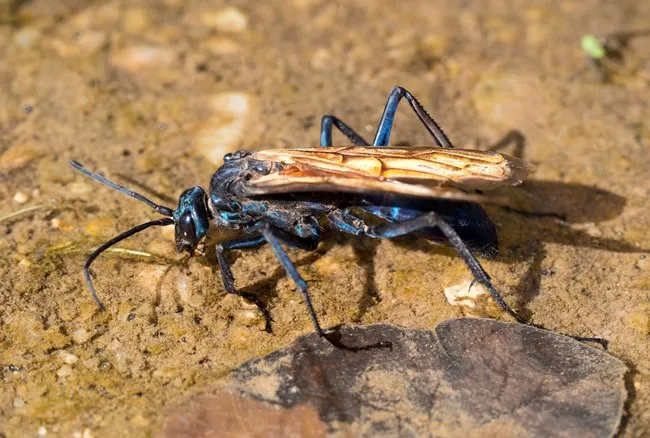
The size and coloration of tarantula hawks are two of their most defining characteristics. As mentioned, they are among the largest wasps, which can be a noticeable difference when compared to other types of wasps. The striking coloration, usually a combination of blue-black bodies and orange wings, serves a purpose beyond mere aesthetics. The colors are a warning signal, a visual cue to deter potential threats. The vibrant wings, when in flight, create a vivid flash, emphasizing their presence in their habitat. The size and coloration also aid in differentiating them from other wasp species, making identification easier. The size and the distinctive color palette of the tarantula hawk are crucial for their survival and serve as a testament to the evolutionary adaptation that has led to their unique appearance.
Habitat and Distribution
Tarantula hawks are primarily found in arid and semi-arid regions around the world. They thrive in environments that provide suitable conditions for both their prey and their nesting behavior. The distribution of these wasps is closely tied to the presence of tarantulas, their primary food source, as well as the availability of resources needed for nesting. They prefer open areas with sparse vegetation where they can easily hunt for tarantulas. The precise habitats can vary across different species, but a common factor is the presence of dry, warm climates. Their adaptability to these harsh environments makes them a fascinating subject for ecological studies. The understanding of habitat and distribution is crucial for comprehending their behavior and the factors that influence their survival.
Where Do They Live?
Tarantula hawks have a preference for specific habitats that support their life cycle. They are most commonly found in the southwestern United States, where their primary prey, tarantulas, are abundant. They also inhabit regions of South America and other arid areas globally. They favor areas with open ground for hunting, with sparse vegetation, and a climate characterized by warm temperatures. These open spaces offer tarantula hawks a better chance to hunt and search for tarantulas. The wasps often build their nests in the ground or in pre-existing cavities, which means they also require areas with suitable soil conditions. Identifying their preferred habitats is key for anyone interested in these fascinating insects and helps in their conservation efforts.
The Southwestern United States
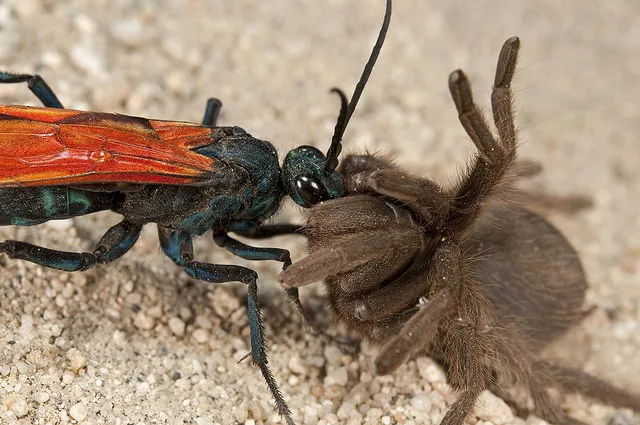
The southwestern United States is a prime habitat for tarantula hawks. The warm, arid climate, along with the presence of several tarantula species, makes this region ideal. The states like Arizona, New Mexico, and Texas offer an abundance of these wasps. The landscape, characterized by deserts, grasslands, and canyons, provides ample hunting grounds and nesting sites. The long, hot summers ensure active wasp populations, as this is when they are most active. The southwestern US is a focal point for tarantula hawk research and observation, offering opportunities to study their behavior and ecological role. The tarantula hawk’s presence in the southwestern US is a sign of the region’s biodiversity and healthy ecosystem, highlighting the delicate balance that sustains their way of life.
Behavior and Lifestyle
The behavior and lifestyle of tarantula hawks are centered around their specialized role as predators and their unique reproductive strategies. They are solitary wasps, with the females being the primary hunters. The males primarily focus on mating. The female’s primary goal is to find and paralyze a tarantula, which will become a host for her egg. Once paralyzed, she drags the tarantula to a burrow and lays an egg on its abdomen. The larva then hatches and feeds on the paralyzed tarantula, consuming it alive. The adult wasps also exhibit nectar-feeding behaviors, supporting their own energy needs. Their lifestyle showcases the beauty and complexity of nature’s predator-prey relationships, highlighting the unique adaptations that enable their survival.
Hunting and Feeding Habits
The hunting and feeding habits of tarantula hawks are perhaps their most captivating aspect. Females are skilled hunters, using their powerful sting to paralyze tarantulas, usually in their burrows. The sting itself is notoriously painful, but the wasp is rarely aggressive unless threatened. Once the tarantula is paralyzed, the wasp drags it to a burrow, a remarkable feat of strength, where she lays a single egg on the tarantula’s abdomen. The larva then hatches, feeding on the paralyzed prey until it eventually pupates and emerges as an adult wasp. Adult tarantula hawks also feed on nectar and pollen, supplementing their diet and providing energy for their activities. Understanding these habits is crucial for appreciating the full scope of their ecological role and their intricate relationship with tarantulas.
Nesting and Reproduction
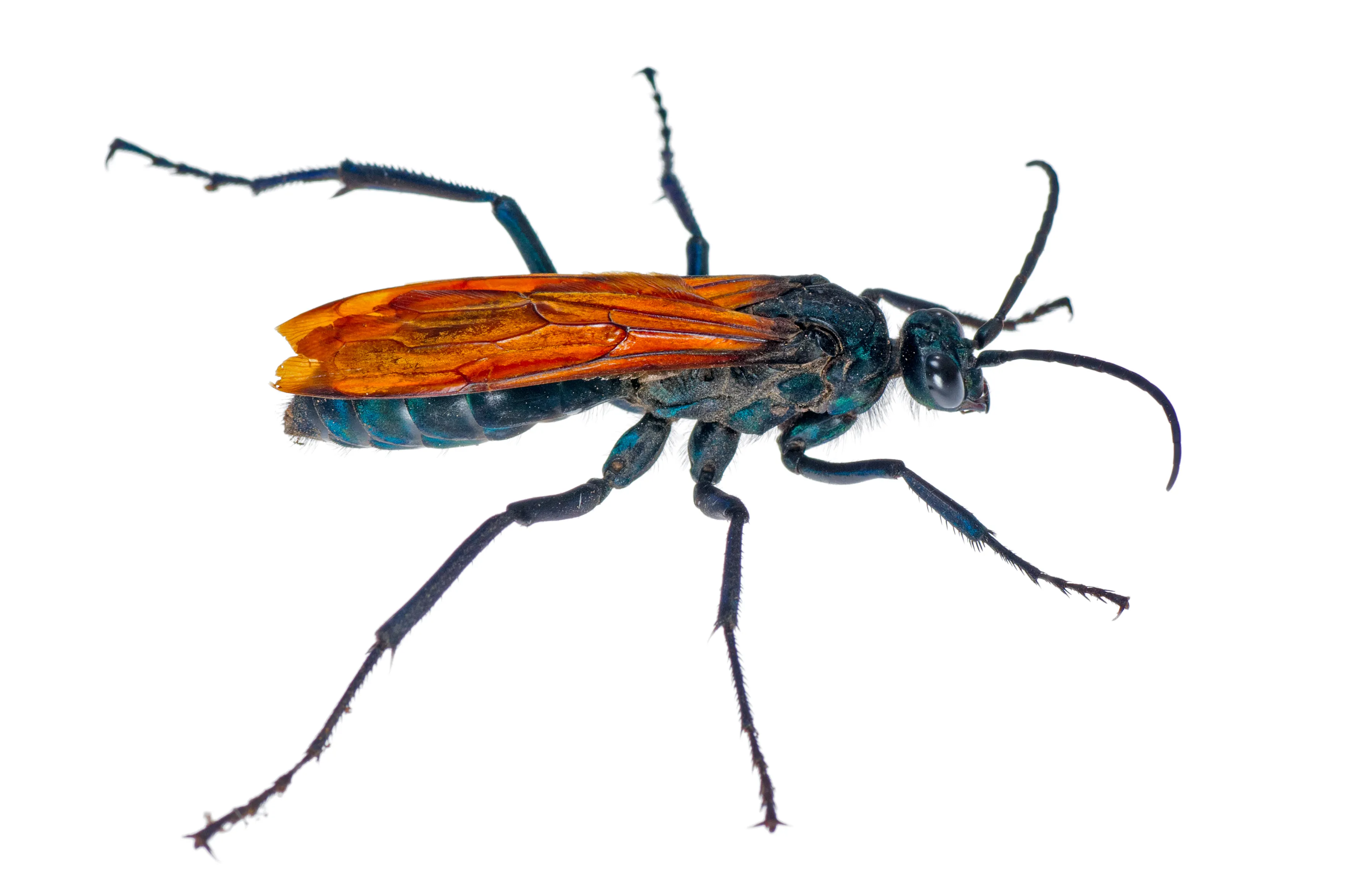
Nesting and reproduction are critical aspects of the tarantula hawk’s lifecycle. After paralyzing a tarantula, the female wasp drags it to a pre-existing burrow or digs a new one, often in the ground. She then lays a single egg on the tarantula’s abdomen, sealing the burrow. The larva, when it hatches, feeds on the still-living tarantula, gradually consuming it over a period of weeks. After feeding, the larva spins a cocoon and pupates, undergoing metamorphosis. The adult wasp then emerges from the cocoon, completing the cycle. Their nesting and reproductive strategies reflect their solitary nature and the significant investment they make in each offspring. These are adaptations to ensure the survival of the species in challenging environments.
The Tarantula Hawk Sting: A Painful Experience
The sting of a tarantula hawk is widely regarded as one of the most painful insect stings in the world. It’s a crucial part of their hunting behavior, as it paralyzes their prey. The pain is intense and described as excruciating, but fortunately, the sting itself isn’t typically life-threatening to humans. However, the pain can last for several minutes, making it a memorable experience. While the stinger is formidable, tarantula hawks are not inherently aggressive towards humans. They generally only sting if they feel threatened. The severity of the pain and the nature of the sting have made it a topic of scientific study, contributing to our understanding of pain perception and the effects of insect venom.
The Schmidt Sting Pain Index
The Schmidt Sting Pain Index provides a scientific scale to assess the relative pain caused by different insect stings. Developed by entomologist Justin O. Schmidt, this index rates the pain level on a scale of 1 to 4, with 4 being the most painful. The tarantula hawk sting is rated at a 4, placing it at the top of the scale. The rating is based on Schmidt’s personal experience, as well as reports from numerous individuals who have been stung. The index helps scientists quantify and compare the pain associated with various stings, providing valuable insight into insect venoms and the effects of these stings on humans. It is a tool that is used to understand the complexities of these insects’ stings and their impacts.
What Happens During a Sting?
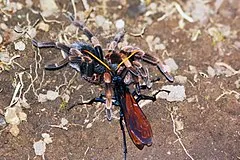
When a tarantula hawk stings, venom is injected into the victim’s body, which causes intense pain. The sting itself is often described as an immediate, searing, and excruciating pain. The pain often comes in waves, which can make it hard to cope with. The venom is designed to paralyze the tarantula, but in humans, it triggers a strong pain response. The duration of the pain varies but can last for several minutes. Despite the intensity of the pain, stings from these wasps are usually not medically dangerous. The local reaction to the sting may include swelling, redness, and a burning sensation. The experience can be extremely unpleasant, and proper handling and precautions are important to avoid being stung.
What to Do if Stung?
If you are stung by a tarantula hawk, there are several steps you can take to manage the situation. First and foremost, remain calm. Seek a safe environment and remove yourself from the area to avoid any further stings. You can attempt to remove the stinger if it is visible, but don’t squeeze the area as this could inject more venom. Apply an ice pack or cold compress to the sting site to reduce pain and swelling. If you experience any severe symptoms such as difficulty breathing, swelling of the face or throat, or dizziness, seek immediate medical attention, as these could indicate an allergic reaction. In most cases, the pain will subside within a few minutes, but it is always wise to monitor your reaction to the sting.
How to Handle Tarantula Hawks (Top 5 Tips)
Dealing with tarantula hawks requires caution and awareness of their behavior and environment. These wasps are not inherently aggressive, but they will defend themselves if they feel threatened. Therefore, it’s crucial to take precautions. It’s best to appreciate these insects from a distance. Here are five key tips to help you safely interact with them and reduce the chances of being stung, allowing you to observe and admire these remarkable creatures while minimizing risks.
Tip 1 Maintain a Safe Distance
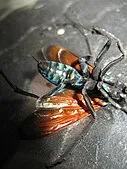
The first and most important tip for safely interacting with tarantula hawks is to maintain a safe distance. Give the wasps plenty of space, especially when observing them in their natural habitat. Avoid approaching their nests or areas where they are actively hunting or dragging tarantulas. Using binoculars or a camera with a zoom lens allows you to observe them without getting too close. When hiking or exploring, keep a watchful eye out for these wasps, paying close attention to their surroundings. A safe distance allows you to appreciate the wasp’s beauty without running the risk of an unnecessary encounter.
Tip 2 Avoid Sudden Movements
Sudden movements can startle tarantula hawks and trigger a defensive reaction. When in areas where these wasps are present, move slowly and deliberately. Avoid making any jerky or fast motions, which could be perceived as a threat. If you see a tarantula hawk, try to stay still and observe its behavior. If you need to move, do so slowly and calmly. These precautions reduce the likelihood of startling the wasp and provoking a defensive sting. By remaining calm and avoiding sudden movements, you can minimize the chances of a negative interaction.
Tip 3 Wear Protective Clothing
Wearing protective clothing is a good idea when you are in areas where tarantula hawks are known to be present, particularly when you are working or hiking outdoors. Long sleeves, long pants, and closed-toe shoes can act as a barrier against stings. Light-colored clothing is also a good choice, as darker colors may attract the wasps. If you are working in an area with a high risk of encountering these wasps, consider wearing gloves and a hat for added protection. Protective clothing does not guarantee you’ll avoid a sting, but it can significantly reduce the risk and minimize the severity of any possible injuries. This is an effective way to ensure your safety when you are around the insects.
Tip 4 Know Their Habitats
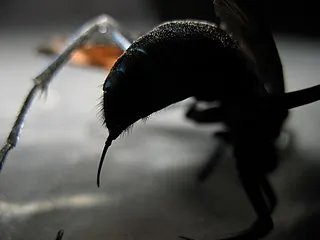
Understanding the habitats where tarantula hawks live is crucial for avoiding encounters. Research the specific areas you plan to visit and learn where these wasps are most likely to be found. They favor arid and semi-arid environments, particularly in the southwestern United States and other regions with a warm climate. They are often found near tarantula burrows and in open, sunny areas with sparse vegetation. Being aware of their typical habitats allows you to take precautions and avoid areas where they are most active. When hiking, exploring, or working outdoors, be mindful of these areas and take the necessary steps to minimize your exposure.
Tip 5 Seek Professional Help When Necessary
If you encounter a tarantula hawk nest or have a serious concern about their presence, seeking professional help is a sensible option. Contacting local pest control experts or wildlife removal services can provide expert advice and assistance in safely dealing with these wasps. Professionals are trained to handle wasps and can safely remove nests or implement strategies to minimize human-wasp interactions. They can also assess the area and suggest preventative measures to minimize the risk of future encounters. If you or anyone in your area is dealing with any issues with tarantula hawks, never hesitate to contact qualified professionals, who can ensure safe and effective resolutions to any problems.
Tarantula Hawks and Humans Interactions
Interactions between tarantula hawks and humans are relatively infrequent, but it is essential to understand the potential risks and benefits associated with their presence. While their sting is extremely painful, these wasps are not inherently aggressive. They generally only sting when they feel threatened. Their presence can also be an indicator of a healthy ecosystem, as they play a role in regulating tarantula populations. Understanding the potential benefits of these wasps and taking necessary precautions when in their environment can foster a more respectful coexistence between humans and these fascinating insects.
The Benefits and Risks
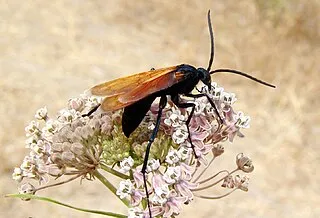
The benefits of tarantula hawks are often overlooked, but they do contribute to the ecosystem. They help control tarantula populations, which can prevent these spiders from becoming too abundant. The risks, however, are the potential for stings, which can be extremely painful. While stings are not usually life-threatening, they can be a very unpleasant experience. Proper precautions, such as avoiding sudden movements and wearing protective clothing, can greatly reduce the risk of being stung. Understanding the benefits and risks can inform how we interact with these insects, appreciating their role in the environment while taking precautions to protect ourselves.
Conservation Status and Threats
The conservation status of tarantula hawks is generally considered to be of Least Concern, although their populations can be affected by habitat loss and pesticide use. As with many species, the loss of habitat due to development, agriculture, and climate change can reduce their suitable environments and negatively affect tarantula hawk populations. The use of pesticides, especially broad-spectrum ones, can also affect these wasps, as it can eliminate their prey and impact their survival. Supporting habitat preservation and promoting responsible pesticide practices are essential to ensure the long-term survival of these incredible insects. Conservation efforts are important to protecting both the wasps and their habitats.
